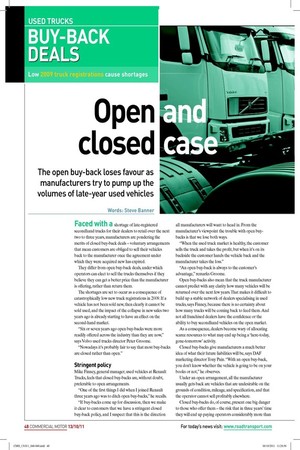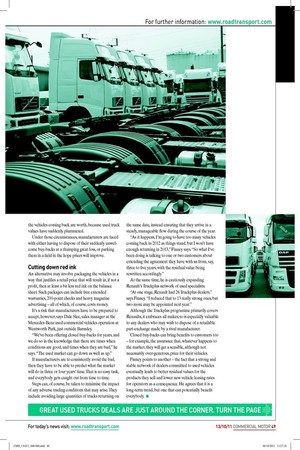Open closed
Page 42

Page 43

If you've noticed an error in this article please click here to report it so we can fix it.
The open buy-back loses favour as manufacturers try to pump up the volumes of late-year used vehicles
Words: Steve Banner Faced with a shortage of late-registered secondhand trucks for their dealers to retail over the next two to three years, manufacturers are pondering the merits of closed buy-back deals – voluntary arrangements that mean customers are obliged to sell their vehicles back to the manufacturer once the agreement under which they were acquired new has expired.
They differ from open buy-back deals, under which operators can elect to sell the trucks themselves if they believe they can get a better price than the manufacturer is offering, rather than return them.
The shortages are set to occur as a consequence of catastrophically low new truck registrations in 2009. If a vehicle has not been sold new, then clearly it cannot be sold used, and the impact of the collapse in new sales two years ago is already starting to have an effect on the second-hand market.
“Six or seven years ago open buy-backs were more readily offered across the industry than they are now,” says Volvo used trucks director Peter Groome.
“Nowadays it’s probably fair to say that most buy-backs are closed rather than open.”
Stringent policy
Mike Finney, general manager, used vehicles at Renault Trucks, feels that closed buy-backs are, without doubt, preferable to open arrangements.
“One of the irst things I did when I joined Renault three years ago was to ditch open buy-backs,” he recalls.
“If buy-backs come up for discussion, then we make it clear to customers that we have a stringent closed buy-back policy, and I suspect that this is the direction all manufacturers will want to head in. From the manufacturer’s viewpoint the trouble with open buybacks is that we lose both ways.
“When the used truck market is healthy, the customer sells the truck and takes the proit, but when it’s on its backside the customer hands the vehicle back and the manufacturer takes the loss.” “An open buy-back is always to the customer’s advantage,” remarks Groome.
Open buy-backs also mean that the truck manufacturer cannot predict with any clarity how many vehicles will be returned over the next few years. That makes it dificult to build up a stable network of dealers specialising in used trucks, says Finney, because there is no certainty about how many trucks will be coming back to feed them. And not all franchised dealers have the conidence or the ability to buy secondhand vehicles on the open market.
As a consequence, dealers become wary of allocating scarce resources to what may end up being a ‘here-today, gone-tomorrow’ activity.
Closed buy-backs give manufacturers a much better idea of what their future liabilities will be, says DAF marketing director Tony Pain. “With an open buy-back, you don’t know whether the vehicle is going to be on your books or not,” he observes.
Under an open arrangement, all the manufacturer usually gets back are vehicles that are undesirable on the grounds of condition, mileage, and speciication, and that the operator cannot sell proitably elsewhere.
Closed buy-backs do, of course, present one big danger to those who offer them – the risk that in three years’ time they will end up paying operators considerably more than the vehicles coming back are worth, because used truck values have suddenly plummeted.
Under those circumstances, manufacturers are faced with either having to dispose of their suddenly unwelcome buy-backs at a thumping great loss, or parking them in a ield in the hope prices will improve.
Cutting down red ink
An alternative may involve packaging the vehicles in a way that justiies a retail price that will result in, if not a proit, then at least a bit less red ink on the balance sheet. Such packages can include free extended warranties, 200-point checks and heavy magazine advertising – all of which, of course, costs money.
It’s a risk that manufacturers have to be prepared to accept, however, says Dale Slee, sales manager at the Mercedes-Benz used commercial vehicles operation at Wentworth Park, just outside Barnsley.
“We’ve been offering closed buy-backs for years, and we do so in the knowledge that there are times when conditions are good, and times when they are bad,” he says. “The used market can go down as well as up.” If manufacturers are to consistently avoid the bad, then they have to be able to predict what the market will do in three or four years’ time. That is no easy task, and everybody gets caught out from time to time.
Steps can, of course, be taken to minimise the impact of any adverse trading conditions that may arise. They include avoiding large quantities of trucks returning on the same date, instead ensuring that they arrive in a steady, manageable low during the course of the year.
“As it happens, I’m going to have too many vehicles coming back in 2012 as things stand, but I won’t have enough returning in 2013,” Finney says. “So what I’ve been doing is talking to one or two customers about extending the agreement they have with us from, say, three to ive years, with the residual value being rewritten accordingly.” At the same time, he is cautiously expanding Renault’s Truckplus network of used specialists.
“At one stage, Renault had 26 Truckplus dealers,” says Finney. “I reduced that to 13 really strong ones, but two more may be appointed next year.” Although the Truckplus programme primarily covers Renaults, it embraces all makes, so is especially valuable to any dealers who may wish to dispose of a retailable part-exchange made by a rival manufacturer.
Closed buy-backs can bring beneits to customers too – for example, the assurance that, whatever happens to the market, they will get a sensible, although not necessarily over-generous, price for their vehicles.
Finney points to another – the fact that a strong and stable network of dealers committed to used vehicles eventually leads to better residual values for the products they sell and lower new vehicle leasing rates for operators as a consequence. He agrees that it is a long-term trend, but one that can potentially beneit everybody. ■













































